A predictive dialer system is essentially a computerized telephone system for call centers designed to connect sales agents to potential customers the predictive dialer software calls automatically. When the Computer Telephony Integration industry began (in the late 1990’s), auto dialer software was created to automatically dial telephone numbers for call center agents who were waiting for the next customer connected. This was normally done with plug-in boards such as Dialogic cards. These systems have also been referred to as “computer aided dialing” whereas auto dialers have also been called, “preview dialing”, “automated dialers”, and “telemarketing dialers”.
A predictive dialer system goes a step beyond the auto dialer software by using algorithms that analyze the call statistics and performance of the call center agents to predict when the next agent will be available and therefore adjusting the rate it calls potential customers. The goal is to minimize idle time for the call center agents and get more sales. If you have ever received a phone call and waited seconds for “the caller” to say something, a predictive dialer system has initiated a call and there is no call center agent yet available.
The predictive dialer software automatically drops unanswered calls, busy numbers, line disconnects, and automated answering devices (e.g., fax machines and voicemail systems).
Statistics show that call center agents increase their sales time on the phone from 20 minutes per hour on average to just under fifty minutes per hour. This is achieved by saving the agent from dialing numbers, waiting for the phone to ring, and dealing with unanswered or answering systems.
How A Predictive Dialer System Works
The calling list is loaded from a database (typically a telephone directory or a targeted listing from a supplier) into the predictive dialer software prior to running a campaign. The system begins making calls and collecting statistics to make its predictions and increase efficiency. Some systems analyze unsuccessful calls and try to call them back later if appropriate, or it may flag the number for autodialing for an agent to listen to the message and work it appropriately.
Generally, the software will monitor answering statistics to agent call period statistics and settle on a call-to-available agent ratio between “1.5 to 1” and “2 to 1”. In other words, approximately 2 numbers are dialed for each “soon to be available” agent. If the predictive dialer software under estimates and dials too few numbers, agents will sit idle. If the PDS over estimates and makes to many calls, customers will say “Hello” a couple of times and hang up or the PDS will drop the call. This last scenario is known as a “Silent Call” or “Nuisance Call”, and in the United States and the United Kingdom there are regulatory limits (carrying large fines) for too many silent calls per hour (in 2018/2019, the limit is 3%).
Some of the statistics the software collects to optimize this delicate balance are listed below:
- Number of phone lines available
- Current call connection rates (i.e., probability of answered calls versus busy, unanswered, fax/machines, voicemail, and network dropped calls)
- Average call connection rates in the recent past (by day and time of day)
- Average agent connection time (average conversation time and average time to enter relevant data)
- Geographic location called
Incidentally, the smaller the cadre’ of call center agents, the more likely the predictive dialer system will “miss the mark” in matching calls dialed to available agents.
Other Applications For Predictive Dialer Systems (PDS):
A PDS is most often used for telemarketing, but it can also be used for many other call center applications. For example, a predictive dialer can provide welcome calls to new customers, provide customer service call backs when someone is available to address a question or issue, remind and confirm appointments, bill collection, delivery notifications, employee communications or distribution, fund raising, automated voice messaging to the elderly, and as an auto dialer for any many other kinds of large volume calling such as distributing personal messages en masse (e.g., campaigning). Predictive dialing systems can even automate the process of updating customer records, submitting sales orders, send customized emails and faxes, etc.
Some systems can also be used to handle incoming calls for applications such as Inbound Messaging Center, urgent notifications (where the customer can leave a message of his issue, and you will be notified immediately), or your company’s voicemail system.
Call Statistics
For a typical calling list, 25-35% of the numbers called on average will result in someone actually answering the phone. On average, 10% will be answered by voicemail/answering machines, fax machines, or modems; 5% will be busy; and 40-60% will not be answered at all. Thus, if done manually, call center agents will waste approximately 80% of their time, and therefore spending about 20% of their time actually selling. Based on these statistics, a predictive dialer system will reverse these two numbers and increase productivity by approximately 300%.
Legal or Regulatory Requirements
As mentioned above, the US and UK require no more than 3% silent call rate per hour. However, additional regulations also apply. For example, the United States requires a “mandatory abandon” message to be played, transmission of Caller ID, and the system must employ “pacing adjustments” to control the rate of calling (hence reducing the “silent call” rate). Your U.S.-based PDS must also comply with the “Do Not Call Registry” and the “Telemarketing Dropped Call Law”.
Predictive Dialer System Architectures
There are various ways to implement the functions of a PDS. They all perform essentially the same set of services, but the performance and cost savings can vary significantly. The 5 fundamental types are briefly discussed below:
Soft Dialers:
“Soft Dialers” are software-only systems which typically cost less to purchase since they do not use telephony hardware (i.e., plug-in boards for computers). The software dialer is typically connected to an existing Private Branch Exchange (PBX) system via the PBX Computer Telephony Integration (CTI) link. Soft dialers typically offer call progress analysis and call classification and integrate to (or may include) voice recording, interactive voice response (IVR), speech recognition, and text-to-speech applications. Newer soft dialer systems exclusively use Voice Over Internet Protocol (VOIP) over the Internet. Older soft dialers tend to use Integrated Services Digital Network (ISDN) messaging or a CTI link.
Soft dialers are proven money-savers, and they offer low initial investment costs and a flexible design for multi-site and distributed network environments. However, some older PBX’s will not work with soft dialers.
Hard Dialers:
“Hard dialers” use telephony hardware boards for call progress analysis and detecting answering machines. Most often, agent audio is connected directly to a PBX via T1, E1, or ISDN signaling. Hard dialers generally require fewer telephony connections since the hardware can connect directly to the Public Switched Telephone Network (PSTN).
Other advantages include hard dialers typically do not need upgrading when the PBX is upgraded, provide better machine and call progress detection, offer “remote agent” capability, generally work with any PBX and sometimes with no PBX, offers higher call capacity (up to approximately 100,000 calls per hour), and faster call connects. However, hard dialers cost more than soft dialers if you already have a PBX or Automatic Call Distributor (ACD) and they cost more to upgrade and maintain.
Smart Dialers:
A “Smart predictive dialer system” is a relatively new option available, and they integrate voice messaging with call center agent connections. In other words, when a call is answer the smart PDS will play an introductory recorded message giving the called party the option to talk with an agent to complete the transaction. This approach offers additional time savings, consistent greeting identifying the caller and reason for the call, and better ratio of calls made to available agents.
Other advantages of the smart PDS include pre-qualifying the call list (saves time and increases productivity), processes a call list faster and more efficiently, agents handle fewer calls with lower rejection rate, and it costs less to process an entire call list due to the aforementioned efficiencies and the need for fewer live agents on staff.
On the downside, however, many people refuse to deal with recordings, and will hang up without even listening to the entire message. You should also verify your state allows recorded messaging before using this feature since it is prohibited in several states. This limitation will reduce the number of potential applications and call list flexibility (e.g., you can use it if you have prior business relationships with the called party). In fact, recorded message calling is illegal in the UK and Australia unless you have prior permission from the called parties.
Hosted Dialer:
The “Hosted dialer” is another new product of the Internet phenomenon. In this “Software as a Service” (SaaS) model, a third-party company “hosts” the predictive dialer system for you; you only need a computer, an Internet connection, and a phone line for each agent. The hosted PDS is also known as “Virtual Predictive Dialers”, “Web-Enabled Predictive Dialers”, and “VOIP Predictive Dialers”).
The pros for this approach include zero up front investment in computers, telephony hardware, software, or licenses, and the service provider covers the administration, support, and software/hardware upgrades. You only pay for the level of service you need or want and your call list (which may also be supplied by the host service provider) … and your agents of course.
The potential downside is if your Internet connection goes down, your telemarketing force sits idle … unless you have a back up plan for manual dialing via the Plain Old Telephone System (POTS). Also, if your hosted dialer provider uses primarily or exclusively VOIP, you will likely have limited reliability and performance; an on-site predictive dialer system generally provides far superior results and control. However, it’s “cost versus performance, complexity, & reliability” trade-off.
Hybrid Dialers:
The final architecture, the “Hybrid Predictive Dialer System”, is usually a soft dialer on a “hosted VOIP provider” for the actual calls. This approach does not connect to a PBX system; it connects to a VOIP service provider via the Internet. The difference between this and the “hosted dialer” system is everything is provided by the “hosted” service whereas the dialer system resides in and is controlled by your facility; the VOIP provider merely provides the calling network access. The hybrid PDS offers all the advantages of soft dialers and a hosted dialer, but it provides lower call capacity than hardware dialers, and the service depends on a working Internet connection.
Your Call List
Hosted dialer providers will often provide you with call lists, or you can purchase them from various companies. If you have your own call list already, many predictive dialer systems will handle the following database standards among others: ACT, Goldmine, FoxPro, and MySQL.
How To Select The Right Predictive Dialer System For You
The instructions below are provided to help you use a strategic approach to learn the market, identify what you need, select a predictive dialer system architecture or type, and then find the service or product you need.
1. Browse/survey several services on the Internet to get a feel for what’s available, prices, services offered, etc.
2. Define the list of services you would like to achieve with your PDS: telemarketing, customer notifications, voicemail, in-bound messaging.
3. Familiarize yourself with your current telephone infrastructure/service and current costs (e.g., Are you currently using an on-site PBX? If so, which brand, model, and capacity. Are you currently using a VOIP provider? Etc.).
4. Once you know what you want and what you already have, it’s time to check the laws for your company locations and the areas you plan to call. Visit the FTC.gov website and search on “predictive dialer telemarketing laws”. As a minimum, you need to understand the “Do Not Call Registry” and the “Telemarketing Dropped Call Law” mentioned above. You must ensure that any PDS you select has the ability to comply with these laws (which should not be a problem at least with U.S. providers).
5. If you haven’t already, you need to determine how many calls you expect to make on a daily basis, how many agents you have (or plan to have), how much call volume you expect as you grow in the future, and how many phone lines you will need.
6. Determine the most appropriate architecture/type of predictive dialer system for you based on the descriptions, pros and cons provided above as well as your survey mentioned in step 1 above: Soft dialer, Hard dialer, Smart dialer, Hosted dialer, or Hybrid dialer. What’s most important to you: initial cost, recurring cost, cost of system maintenance and upgrades, labor cost for your agents, performance and reliability, simplicity, single point of contact for issue resolution, stability, independence for system upgrading, abundance of features, etc.?
7. If you are choosing any system other than the hosted dialer, you must ensure it will be compatible with your existing hardware and software for your PBX(s), VOIP, phone lines, and Internet services.
8. Determine which Operating System (OS) any software residing in your facility requires (Windows or Linux).
Important Predictive Dialer System Features To Consider
- Does the system comply with all legal requirements for your areas and areas you plan to call?
- Initial cost
- Recurring cost
- Cost of temporary loss of service
- Cost and complexity of training (you want sales people to use the system, not engineers or computer scientists)
- Personnel you must have on staff to operate, maintain, and to take calls (agents)
- What are your termination costs if the system doesn’t perform as expected/promised?
- Compatibility with your existing infrastructure
- System capacity in terms of anticipated call volume and number of agents you have (as well as your anticipated volume and team in the future). Can the system grow as you grow? What’s the maximum?
- What OS is required?
- What database software/format is required? Is it compatible with your current database(s) or the formats available from your call list supplier?
- Does the predictive dialer system work with answering machines and voicemail system? How long can such messages be?
- Can the system automatically handle callbacks from busy, machine-answered, and no-answer calls?
- Can the system automatically send follow-up emails and/or faxes?
- Can the system automatically update customer records and/or document results of calls?
- How fast does the system connect a live person to a live agent?
- How many mistakes does it make in routing, dropping calls, etc.?
- If you are pursuing a smart dialer, how long can the introductory message be? Can the system collect answers? How many?
- Does the system provide all the features you want … now (not a feature that’s “in the works”)?
- Can the system run multiple campaigns simultaneously?
- Can the dialer system support a “Remote Agent” capability to route calls to agents anywhere in the world?
- Can the system recognize the time zones of called locations and call only during legal hours for the time zone?
- Can the system host more than one phone number per person to try to reach someone if the first called number isn’t successful?
- Can the system monitor and record calls?
- What level of training is provided? Is it self-paced, simple enough for On-the-Job Training (OJT), or does the provider provide training? Is it hands-on training? Is training covered in the cost of the system or monthly maintenance fee?
- Is the system User-Friendly and fairly intuitive to learn, use, and maintain?
- Do you want to test your results with a “quick and easy” system before moving to the “big time”?
- Can you test drive the system before you invest in it and before you have it installed?
- Can you deploy it on a small scale to “test drive” before committing to a large installation?
- Where are you going to get your leads? Does the provider or host offer leads?
Hopefully, this has provided a decent introduction that will help you and your business. A predictive dialer system can be a tremendous cost saving, profit-boosting addition for your business if you research the market and assess your needs carefully.
ICTBROADCAST
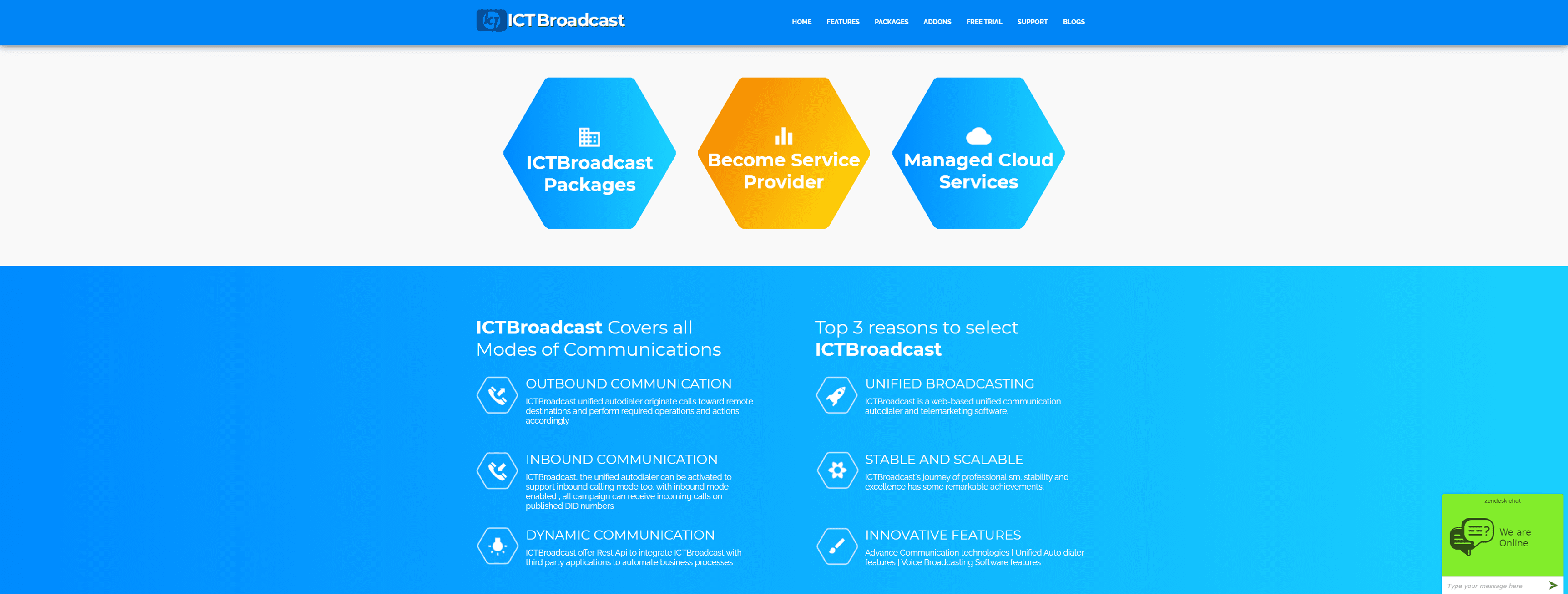
ICTBroadcast is multi tenant, unified communications and telemarketing software solution supporting Voice, SMS, Email and Fax broadcasting, It is auto dialer, power dialer, progressive dialer and predictive dialer software featuring inbound IVR, IVR Studio, press 1 campaign, complete call center, AMD, HLR, DNC, survey, appointment and WebRTC Suitable for small business owners, entrepreneurs and Service Providers.
- Multi-tenant and Multi-campaign
- Unified Broadcasting
- Improved Dashboard
- Campaign Statistics and Reporting
- Advanced User Management
- Surveys and Polls
- Live Monitoring
- Improved Web-based IVR Designer
- Contacts Management
- Scheduling
- External Call Center
- Call Center Support
- Multi Campaign
- Call Queueing and Press 1 Campaign
- Web Phone
- AMD & DNC Support
- Billing and Routing Support
- CRM Integration
- Appointment Reminder
- Inbound & Outbound Call Center
- Rest API’s
- Custom Token and Personal Communications
VOCALCOM

Reliable and easy to manage contact center software designed and optimized for agents to accomplish more and to do it faster in a multichannel world.
Futures:
- Our products serve all sizes, from small to large, multi-site enterprise users
- Frustration-free usability – your grandma could learn it in no time
- We provide the basics – plus an arsenal of power tools
- Add-on options include SMS, email, calling options, and call recording
- No PBX needed. Pay only for what you need, when you need
- Cost-effective path to the latest compliance tools — dial with confidence
Pricing:
Click2Start – 45€/ Concurrent user / Month
Business Plus – 75€/ Concurrent user / Month
Entreprise – 99€/ Concurrent user / Month
Unlimited Power – 135/ Concurrent user / Month
VOICENT

Voicent’s easy-to-use predictive dialer software includes predictive dialing, preview dialing, a progressive dialer, a call center predictive dialer, and manual dialing modes.
Predictive, Preview, and Progressive Dialing:
- Cloud or on-premise solution
- Always a Live Connect
- Run multiple simultaneous campaigns
- Make hundreds of calls per minute
- Alternate Phone System
- Automatic Time Zone Adjustment
- Advanced OptPace™ volume pacing algorithm
- Get detailed campaign reports
Boost Agent Productivity With the Agent Dashboard:
- Automatic CRM popup screen
- Dynamic call scripts
- Call routing and forwarding
- Answer anywhere using PC and headset
- Edit, share, and save CRM information
- Call recording and whisper coaching
Convert Leads to Customers with the Built-in CRM:
- Unlimited contact groups and sublists
- Quick search CRM contacts
- Easy importing and uploading
- Save custom CRM fields
- Automatically generated reports
- Use built-in CRM or integrate CRM
Automate Your Business Workflow:
- Define custom behavior-based triggers
- Multi-channel automation by phone, text, email
- Set up automatic email drip systems
- Run automated marketing campaigns
- Automatic opt in opt out management
- Set up automatic notifications
AIRCALL

Cloud based phone system and call center software all-in-one with Cloud Telephony Integrations (CTI) with your favorite CRM & Helpdesk software.
Call center software set up in one click:
- Virtual call center
- Voicemail
- Business hours
- International numbers
- Call queuing
- IVR
- Warm transfer
- Toll-free numbers
Advanced call center and collaboration features:
- Call center extensions
- Live feed
- Custom filters
- Tags
- Email reporting
- Blacklist numbers
- After Call Work
- Ring Groups
- Parallel Calls
- Shared call inbox
- Call routing
- Assign and comment on calls
- Shared contacts
- Unlimited concurrent calls
- Call Monitoring
- Call Whispering
- Call recording
- Real time modification
- Call center analytics
Integration with your business tools:
- CTI – Computer telephony integration
- Webhooks and APIs
- Google import
- Your call center software built right into your workflow
ALVARIA
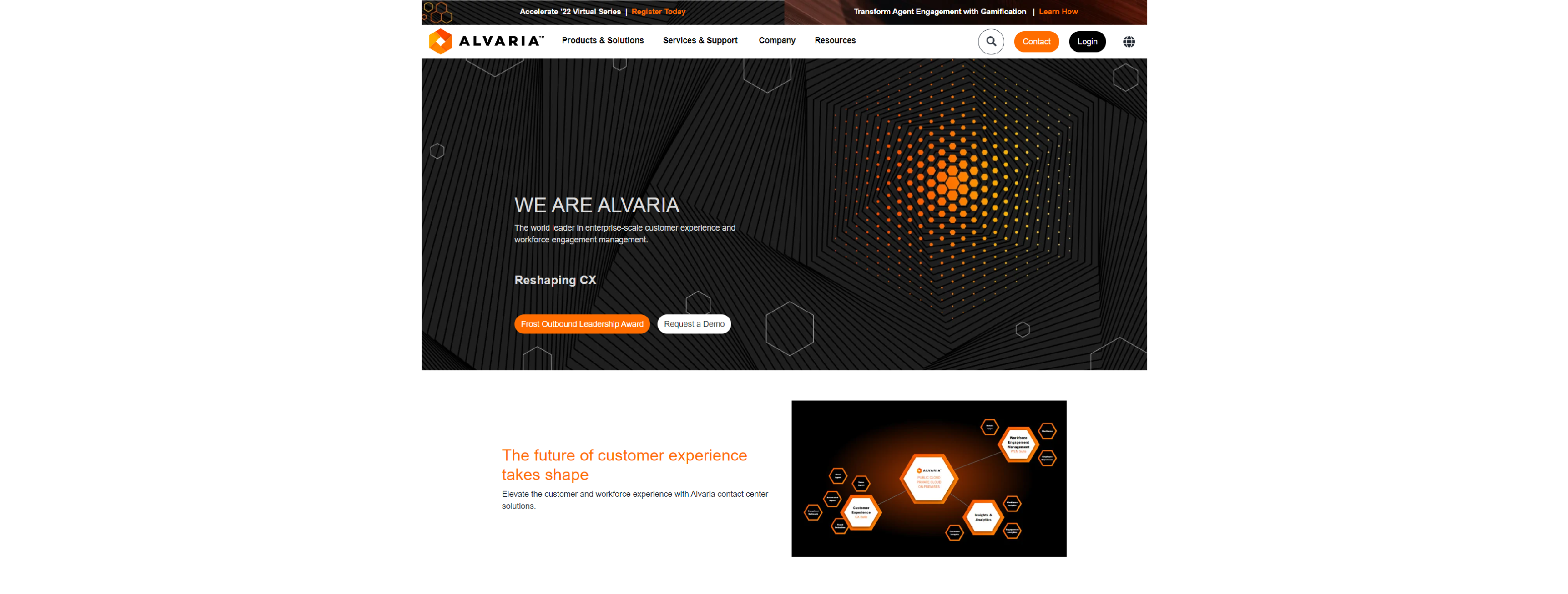
Alvaria is a global enterprise contact center solution provider, delivering leading edge customer experience and workforce engagement software as well as cloud services technology solutions.
- Detect busy signals, fax machines, voicemail and no-answers with configurable reattempt and escalation rules
- Create, modify, stop or start campaigns dynamically, through a single point of administration
- Adjust campaign pacing for improved agent productivity, compliance with abandonment rate laws and effective use of your telephony resources
- Easily manage Do Not Call (DNC) lists, time zones, number portability, attempts and state and local calling rules
- Track and manage mobile numbers and consent
- Provide personalized, proactive outreach via voice, email and SMS
AMEYO
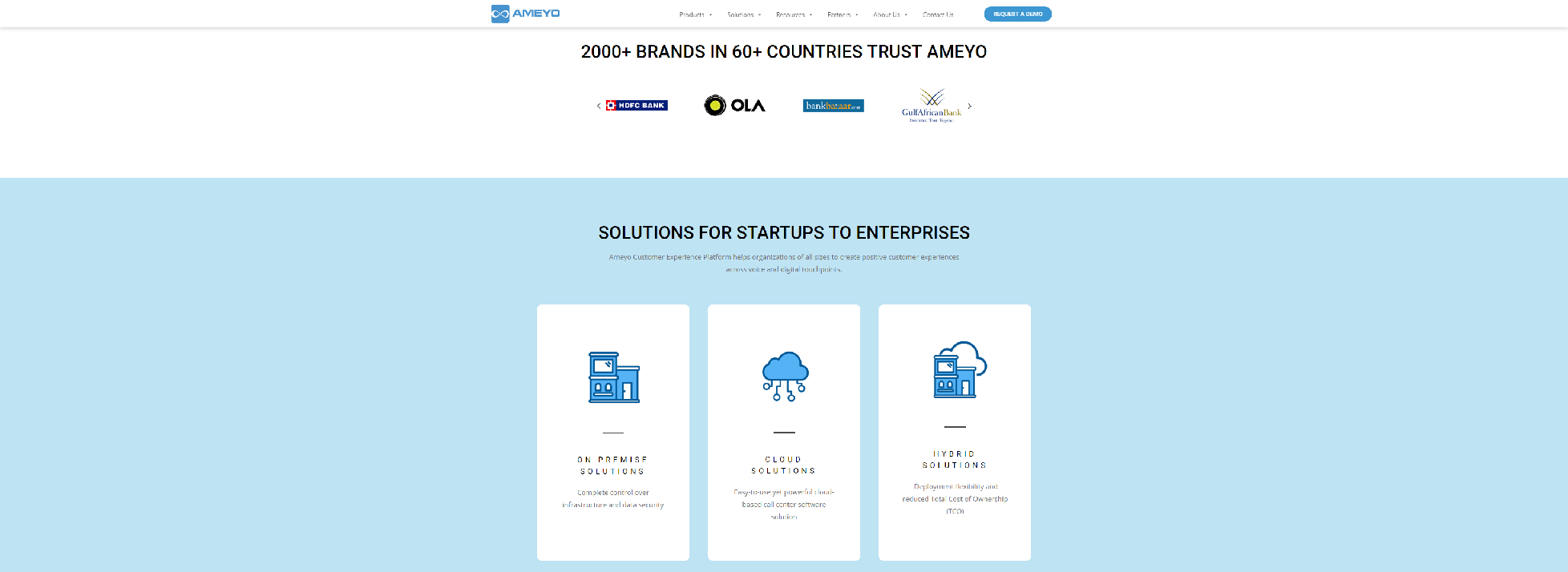
Ameyo’s Call Center Software Solution is the market leader in Omnichannel Customer Experience and Contact Center solution in cloud and on-premises software.
Features:
- Filter-Based Calling
- Dial Time Restriction
- Retry Time Setting
- Answering Machine Detection
- DNC Management
IQAUTODIAL
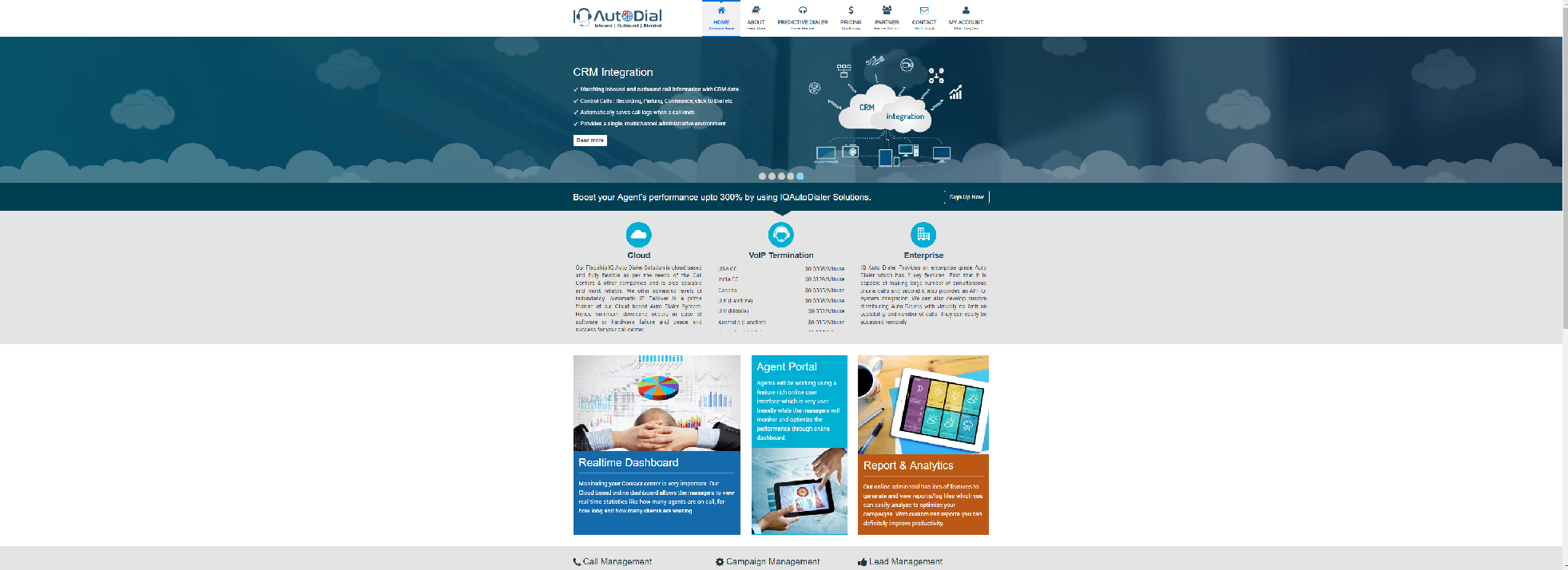
IQ Auto Dial’s predictive dialer software has many ways to raise the sales hastening processes, such as progressive dialing, manual dialing, preview dialing, and cloud-based dialing.
Features:
- Built-in CRM
- Scalable & Flexible
- Cloud-based features
- Ease-of-access interface
- 24/7 online server
- Seamless Applications Integration
- Voicemail Drop
- Outbound Analytics Tools
- Speed Dialing
CALLHUB
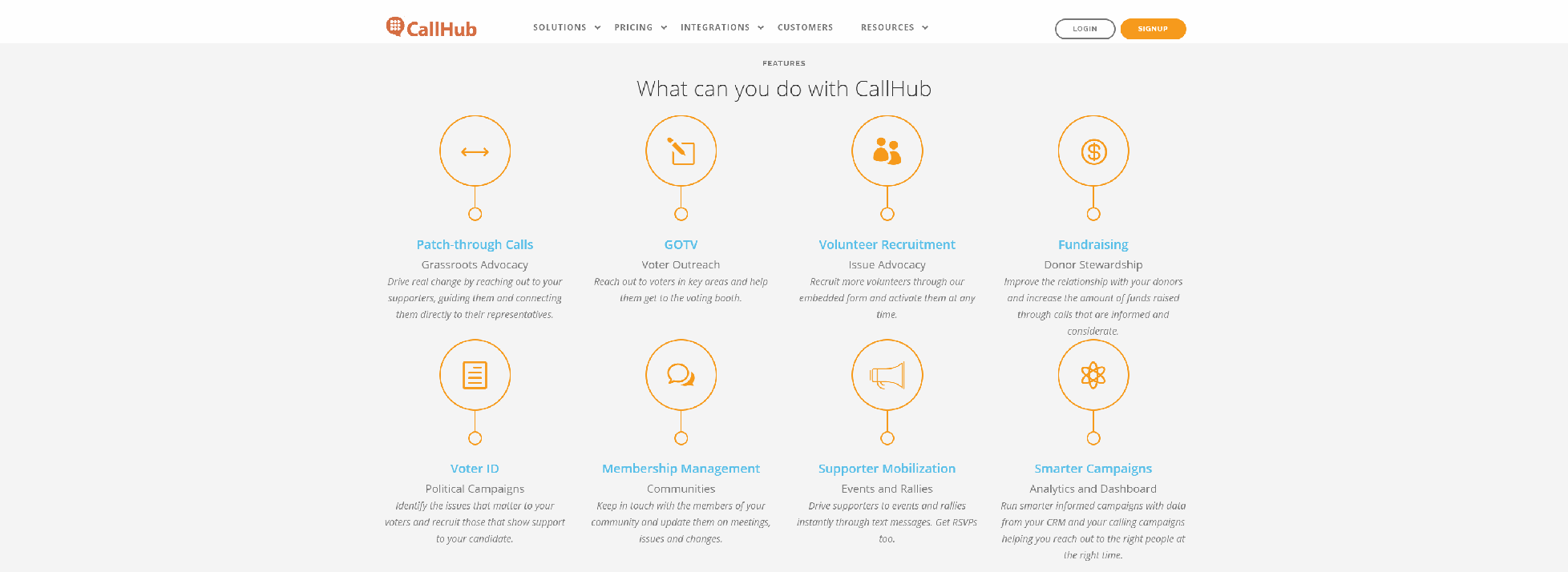
Four automated dialer systems to match every calling requirement. Predictive, Power, Preview and Robo Dialer.
- Phonebook analysis
- Dynamic CallerID
- Analytics Dashboard
- Patch-through calls
- Predictive Dialers
- Custom Fields
CALLCENTERHOSTING
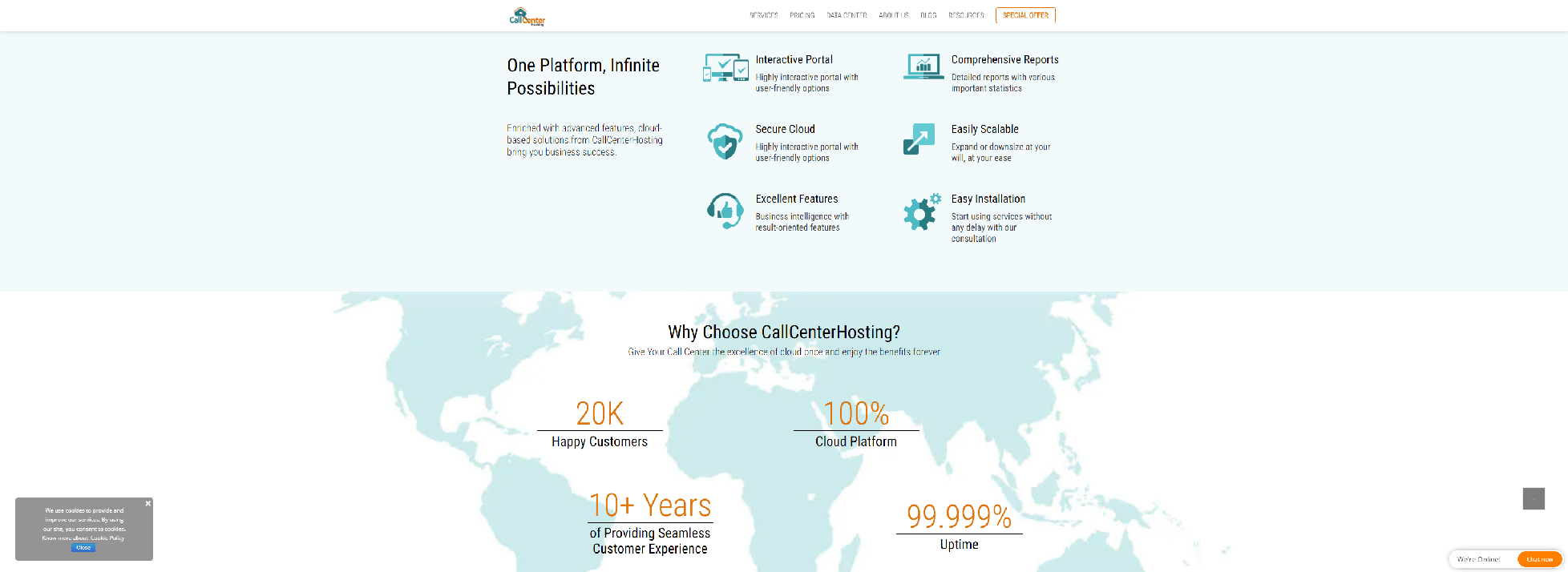
Predictive dialer from CallCenterHosting is an intelligent tool to get connected with customers across the world. 24×7 customer support and FREE trial available.
- Grab Opportunities
- Immediate Customer Support
- Extensive Reports
- CRM Integration
- Customizable Campaigns
- Live Monitoring
- No Hardware Needed
- Make Your Business, Truly Yours
- Interactive Dashboard
- Make A Cloud Move
- 24×7 Customer Support
- Automatic Workflow
- Productivity Booster
- Higher Revenue
CONNECTFIRST
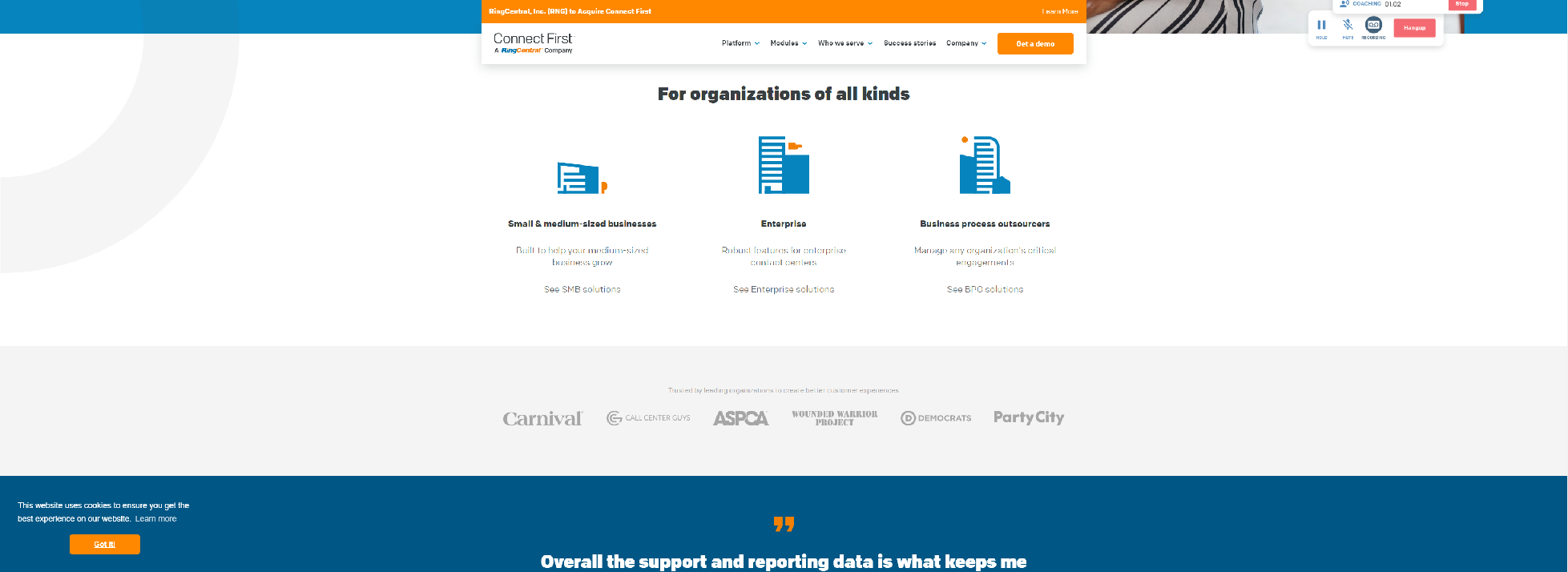
Connect First’s call center software, the most stable, reliable, customer-centric, enterprise-to-small-business platform. Make the switch to better today!
Features:
- Built-in agent monitoring and coaching tools
- Comprehensive WFO/WFM solutions
- Seamless agent blending
- Advanced script building
- Configurable callback tools
- Full suite of queue and campaign configuration tools
- User-friendly customizable agent desktop
- Highly configurable administrative interface
- Easy CRM integration
- Dynamic list loading
- Unlimited simultaneous campaigns
- Predictive pacing algorithms set per campaign
- Text to speech functionality
- Granular pass count (allows a campaign to choose time between passes or dials to a specific phone number)
- Multi-channel IVR (interactive voice response)
- Computer telephony integration (CTI)
- Voice recording
6CDIALER

6C Dialer offers Hosted Predictive Dialer, Hosted Call Center Software Solutions, Voice Broadcasting Service and VoIP Service for High Performance Call centers.
Features:
- Campaign Management
- DNC Management
- Filter Based Calling
- Customized Dial Time
- Lead Management
- Answering Machine Detection
- 6C Interactive Dashboard
- Call back scheduling & reminders
- Reports & Analytics
- CRM Integration
- Custom Call ID